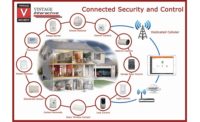There was a time not so long ago when mobile surveillance and the apps that enable it might have been a make-or-break factor when end users purchased a video security system. Today, however, that’s changed in a big way. Not only is mobile capability no longer part of the decision; it could be argued that it’s not even part of the thought process.
That’s because mobile has become so deeply ingrained in our everyday lives that we often take it for granted — maybe not as much as, say, the air we breathe, but for some people, it’s pretty darn close. As a result, mobile surveillance isn’t only expected; it’s just there.
What people use mobile surveillance for has changed as well. The convenience afforded by the ability to access live and recorded video is still a main driver; but as mobile bandwidth availability has increased, situational awareness has become a larger part of the conversation. (See related story on facing page.)
The enhancements mobile capability adds to video surveillance systems add value to these systems, and as such can create additional or increased revenue opportunities for dealers and integrators. However, in order to maximize this potential, you first have to be able to maximize the value customers get — or at the very least perceive they are getting — from mobile surveillance. This requires strong understanding of just how to make this happen.
As with every installation, the first thing to do is set expectations. How does what a customer wants to do with mobile surveillance compare with what they will actually be able to do? This is based on a number of factors, including bandwidth, software and the type of mobile device. There may be nothing worse than a customer who’s irate because their solution lacks the capability to perform one of the main tasks they expected it to perform. Clearly outlining capabilities will defuse these situations before they even start.
There are also a number of basic items dealers and integrators must consider with mobile surveillance, the most notable of which are:
- Supported operating systems and platforms.
- Ease of use of mobile apps.
- Level of quality, resolution and frame rate an app can deliver and display.
- Scalability to support the necessary number of users.
- Any costs associated with a solution, such as licensing or other fees.
- Additional requirements for deployment, such as a dedicated server for a mobile app to connect to.
A number of factors go into determining how a mobile surveillance solution addresses these basics. Below are seven key considerations dealers and integrators can use to help customers get the most out of these solutions.
1. Level of Functionality
The first consideration for helping end users harness the full potential of mobile surveillance is to make sure there is even a “full potential” to be harnessed. While most mobile apps and other viewing clients have come a long way in terms of available features and functionalities, some are watered-down versions of a content management system (CMS) or VMS. This can severely limit the level of security an organization can achieve, says Mark Espenscheid, director of marketing for Cerritos, Calif.-based Digital Watchdog.
“You definitely want to make sure to choose a CMS or VMS with a mobile counterpart that offers as many of the software’s features as possible remotely,” he says.
2 .Upload Bandwidth
The prevalence of high-resolution video makes it vital to understand how much bandwidth will be needed to transmit video across a network. Even compressed video can require substantial network resources. For mobile devices, which may be connected via a range of network types, the important spec to know is the upload bandwidth of the network that’s available at a customer’s site for their specific application.
“Talk to customers about total upload bandwidth available and set expectations about what they’ll be able to see and not see in terms of how many cameras they can view at one time, as well as the capabilities of their mobile device and the local mobile network infrastructure in their location,” says Ahmed Elsayed, sales engineer for Hikvision USA, based in City of Industry, Calif.
For example, he says, if only a 3G mobile network is available, end users will be forced to make sacrifices that will limit the functionality of their mobile surveillance solution.
“They would give up the amount of cameras they can view concurrently and the quality in which they can view them,” Elsayed says. “The speed of the connection dictates the quality they are able to stream and download to their device.”
3. Connectivity Flexibility
Related to the issue of upload bandwidth, understanding how end users would like their mobile surveillance delivered is another important aspect of ensuring their success using mobile surveillance. With this knowledge, integrators can make certain that the solutions and devices they implement will even work with the desired methods.
“If they want to leverage a Wi-Fi network while on site, the mobile app and server need to support this form of connectivity and easily switch to cellular communications when Wi-Fi is not available,” says Jimmy Palatsoukas, senior manager of product marketing for Montreal-based Genetec.
4. Component Capabilities
With all viewing clients, whether a mobile app or something else, it’s important to learn about all of the hardware and the different options it provides with the mobile surveillance interface. Many viewing clients contain key components that add a lot of value to the user experience, says Sean Murphy, regional marketing manager for video systems for Fairport, N.Y.-based Bosch Security.
For example, cameras and VMS equipped with video analytics can generate alarms when preset conditions are detected, such as motion, line crossing, object detection and others. The system may also include the ability to easily export video for external storage, SMS and email alerts when an alarm is triggered. These are just some of the valuable capabilities and options offered by hardware and software solutions. However, if you’re not aware of them and/or can’t inform customers about them, then they’re completely useless.
5. Location Consideration
How will the end user’s security team and/or other staff be accessing the video surveillance system? From where do they work? Are they located on-site, at a remote location, in the field or somewhere else? These are important questions to ask, and the answers will provide a better understanding of the appropriateness of mobile security solutions for an application, as well as the features and functions that will be necessary to deliver the greatest value to customers, Palatsoukas says.
“If staff is always on the move, mobile apps are a key enabling technology, allowing users to always be connected when on the move,” he says.
6. Integration
Is the end user looking for surveillance only from their mobile solution, or are they interested in command and control as well, such as the ability to unlock doors and/or control pan-tilt-zoom cameras? In some cases, security professionals who want these extended capabilities are working with multiple apps for different security systems or specific components of those systems. This is less than ideal, Palatsoukas says, adding that the ability of many mobile apps to integrate or unify these systems and components makes this clunky approach completely unnecessary.
“As opposed to working with multiple apps, going to a unified mobile app results in greater situational awareness, for example having access events on the mobile app that are automatically linked with video,” he says.
7. Field Use
Gaining a better understanding of how users’ security staff currently view, interact with and respond to security events in the field will allow you to present mobile surveillance apps as a more attractive — and often more effective — solution that can increase security levels and ensure faster, more appropriate response.
“A high reliance on using a laptop to log in to a system may mean that operators and users are not as quick to respond due to login time, remote connectivity to a network, etc. So a mobile app makes the most sense when reaction time must be quick,” Palatsoukas says.
By taking these seven factors into consideration, dealers and integrators will find themselves well-positioned to help customers maximize the benefits of mobile surveillance. In addition to improving end users’ security, the ability to match mobile apps with customers’ wants and needs opens the door to potential new revenue for dealers and integrators who take the time to familiarize themselves with the key concepts surrounding mobile surveillance.
SIDEBAR: Situational Awareness
Driven by higher-bandwidth mobile networks, advanced software capabilities and other factors, the use of live video in the field to provide situational awareness is on the increase. Some mobile solutions have evolved to the point where users can stream and control multiple high-resolution video feeds over a mobile connection, which naturally lends itself to incident response.
For example, first responders equipped with mobile devices could view live video from surveillance cameras from a location while on the way to respond to an incident. With this real-time information literally in hand, fire and law enforcement can better assess the situation to determine the safest, most appropriate response. Depending on the situation, it’s conceivable that this could prevent an incident from escalating, avoid injuries or even save lives.
SIDEBAR: Getting to Know You
By definition, all mobile security apps provide basic viewing capability to view video, with most allowing access to both live and recorded video. Most are also available on multiple platforms — iOS, Android, Windows 8, etc. — allowing them to be implemented for pretty much any application.
These are the two main areas where there is little, if any, difference from one app to the next. The differences can be found in the more advanced features and functionality, which vary wildly from manufacturer to manufacturer. Many apps will deliver push notifications and provide the ability to control cameras; but these are not necessarily universal, and the means by which they are provided can be very different as well.
Some of the more advanced or unique capabilities mobile apps deliver include:
- The ability to push live video to mobile devices when alarms are generated.
- The ability to store and manage video on a mobile device.
- Integration with other security and non-security systems.
- Scalability to meet the needs of customers ranging from single-camera home users to enterprise security directors.
- Number of video streams supported.
- Intuitiveness and ease-of-use of the interface.
- Resolution the app is capable of receiving and displaying (including the flexibility to vary frame rates and resolution to adapt to available bandwidth).
- Security features, such as level of encryption or the ability to restrict access to the app if a device is lost or stolen.
This is by no means an exhaustive list, but rather a sampling of some of the most notable features and functions available. The many differences between offerings make it essential for dealers and integrators to familiarize themselves with the apps from the vendors whose products they sell and install. What’s important to remember is that the best way to help customers get the most of their mobile surveillance solution is not to overwhelm them with functionality but to make sure it delivers what they need for their specific application. Given the breadth and depth of available solutions, there should be something for everyone.





